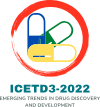Speaker
Description
The research work deals with the design, synthesis, and characterization of a series of 6substituted-4-hydroxy-1-(2-substituted thiazole-4-yl)-quinoline-2(1H)-one derivative [III(a-d)(1-3)] and evaluation of their in vitro anticancer activity against MDA-MB (Breast cancer) and A549 (Lung cancer) cell lines. A series of substituted thiazole-4-yl-quinolin-2(1H)-one derivative [III(a-d)(1-3)] were synthesized from starting material, substituted 4-hydroxyquinoline-2(1H)-ones I(a-d) as per the literature. Compounds I (a-d) were further subjected to condensation with chloroacetyl chloride to obtain 6-substituted-1-(2-chloroacetyl)-4-hydroxyquinoline-2(1H)-ones II (a-d). Finally, condensation with thiourea or thiamide through Hantzsch’s thiazole synthesis yields twelve derivatives of 6-substituted4-hydroxy-1-(2-substituted thiazole-4-yl)quinoline-2(1H)-ones [III(a-d)(1-3)]. The synthesized derivatives were characterized by spectral analysis. They were tested for their in vitro anticancer activity against MDA-MB (Breast cancer) and A549 (Lung cancer) cell lines by 3-(4,5-dimethylthiazol-2-yl)-2,5-diphenyltetrazolium bromide (MTT) assay method. Molecular docking studies of the synthesized compounds exhibited well-conserved hydrogen bond interactions with one or more amino acid residues in the EGFRK tyrosine kinase domain (PDB ID: 1M17) for docking study on anticancer activity. The compounds were tested for their in vitro anticancer activity against MDA-MB (Breast cancer) and A549 (Lung cancer) cell lines at 31.25, 62.5, 125, 250, and 500 µg/mL concentration using the MTT assay method. All synthesized derivatives were potent against the A549 (Lung cancer) cell line compared to the MDA-MB (Breast cancer) cell line. Compound 6-fluoro-4-hydroxy-1-(2-phenylthiazol-4-yl)-quinoline-2(1H)-one (IIIc-3) exhibited the highest MolDock score (-102.535), which was comparable to that shown by the standard Imatinib (-116.362) for anticancer docking and was found to be the most cytotoxic as compared to the other synthesized derivatives, with IC$_{50}$ values of 397.56 μg/mL against A549 (Lung cancer) cell line. The synthesized derivatives showed good activity compared to the standard drug and hence possessed a potential to bind with some of the residues of the active site and can be further developed into potential pharmacological agents.
